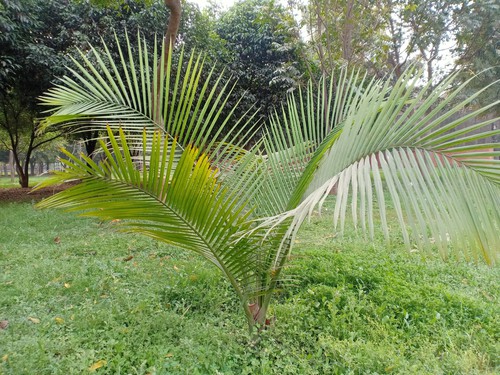Majesty palms are a popular houseplant choice due to their tropical flair and ability to thrive indoors. However, many plant owners may notice majesty palm turning yellow and brown, which can be concerning.
Identifying symptoms of a sick majesty palm is the first step in determining the cause of the issue. Yellowing leaves can be a sign of improper watering, insufficient light conditions, or nutrient deficiency, while brown leaves can indicate many different health problems.
In some cases, pests or low humidity can also cause yellowing or browning.
Proper care for majesty palms is essential for their health and longevity. This includes providing them with the right amount of light, water, and nutrients.
Reviving a sick majesty palm may require adjusting these factors and addressing any underlying issues. Preventing future issues can be achieved by maintaining proper care and addressing any issues as soon as they arise.
Key Takeaways
- Identifying symptoms of a sick majesty palm is crucial in determining the cause of yellowing or browning leaves.
- Proper care for majesty palms includes providing them with the right amount of light, water, and nutrients.
- Reviving a sick majesty palm may require adjusting care factors and addressing underlying issues to prevent future issues.
More on this category:
- Majesty Palm Leaves Turning Yellow and Brown
- Corn Leaves Turning Yellow and Brown
- Juniper Turning Yellow and Brown
Identifying Symptoms of a Sick Majesty Palm
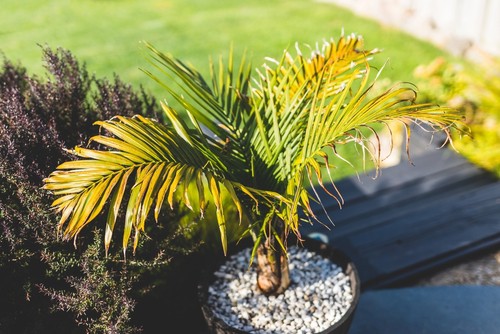
Majesty palms are beautiful tropical plants that can bring a touch of the exotic to any indoor space. However, like any plant, they can become sick and develop symptoms that indicate a problem.
If you notice that your Majesty palm is turning yellow or brown, it is important to identify the cause of the problem so that you can take appropriate action. In this section, we will discuss the most common symptoms of a sick Majesty palm and what they might mean.
1. Yellowing Leaves
One of the most common symptoms of a sick Majesty palm is yellowing leaves. This can be caused by a variety of factors, including:
- Insufficient light: Majesty palms require a lot of light to thrive, and if they don’t get enough, their leaves can turn yellow.
- Overwatering: Too much water can cause the roots of the Majesty palm to rot, which can lead to yellowing leaves.
- Nutrient deficiency: If the plant is not getting enough nutrients, its leaves may turn yellow.
If you notice that your Majesty palm’s leaves are turning yellow, try moving it to a brighter location and adjusting your watering schedule. You may also want to consider fertilizing the plant with a balanced fertilizer.
2. Brown Leaves
Brown leaves are another common symptom of a sick Majesty palm. This can be caused by:
- Underwatering: If the plant is not getting enough water, its leaves may turn brown and dry out.
- Over-fertilization: Too much fertilizer can burn the roots of the Majesty palm, causing its leaves to turn brown.
- Low humidity: Majesty palms prefer a humid environment, and if the air is too dry, their leaves may turn brown.
If you notice that your Majesty palm’s leaves are turning brown, try adjusting your watering schedule and increasing the humidity in the room. You may also want to flush the soil with water to remove excess fertilizer.
3. Brown Spots
Brown spots on the leaves of a Majesty palm can be a sign of a fungal or bacterial infection. This can be caused by:
- Overwatering: If the plant is getting too much water, it may develop a fungal or bacterial infection.
- Poor air circulation: If the air around the plant is stagnant, it may be more susceptible to fungal or bacterial infections.
If you notice brown spots on your Majesty palm’s leaves, try adjusting your watering schedule and increasing air circulation around the plant. You may also want to consider treating the plant with a fungicide or bactericide.
4. Brown Tips
Brown tips on the leaves of a Majesty palm can be caused by a variety of factors, including:
- Low humidity: If the air around the plant is too dry, its tips may turn brown.
- Over-fertilization: Too much fertilizer can burn the tips of the Majesty palm’s leaves, causing them to turn brown.
- Underwatering: If the plant is not getting enough water, its tips may turn brown and dry out.
If you notice brown tips on your Majesty palm’s leaves, try increasing the humidity in the room and adjusting your watering schedule. You may also want to flush the soil with water to remove excess fertilizer.
Majesty Palm Turning Yellow and Brown – 6 Common Problems
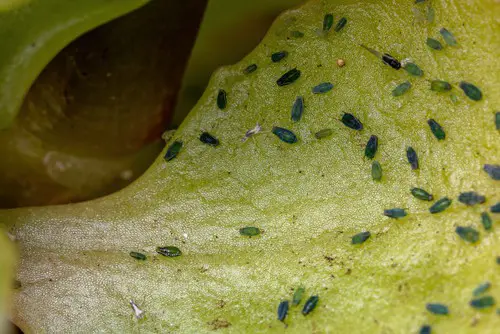
Majesty palms are popular houseplants that can add a tropical feel to any room. However, they can be sensitive to changes in their environment and may develop yellow or brown leaves. Understanding the common causes of these issues can help you keep your majesty palm healthy and thriving.
1. Overwatering
Overwatering is a common cause of yellowing and browning in majesty palms. When the soil is constantly wet, the roots can become damaged, making it difficult for the plant to absorb nutrients. This can lead to yellowing or browning of the leaves.
If you suspect overwatering, allow the soil to dry out before watering again and make sure the pot has proper drainage.
2. Underwatering
On the other hand, underwatering can also cause yellowing and browning in majesty palms. When the soil is too dry, the plant may not be able to absorb enough water and nutrients. This can cause the leaves to turn yellow or brown and may eventually lead to leaf drop.
If you suspect underwatering, water the plant thoroughly and make sure the soil is consistently moist.
3. Low Humidity
Majesty palms are native to humid environments, so low humidity can also cause yellowing and browning. When the air is too dry, the leaves may lose moisture and turn yellow or brown. To increase humidity, you can mist the leaves with water or use a humidifier.
4. Improper Light
Majesty palms require bright, indirect light to thrive. If they are exposed to direct sunlight or kept in a dark room, they may develop yellow or brown leaves. If you suspect improper light, move the plant to a brighter location, but avoid direct sunlight.
5. Nutrient Deficiency
A lack of nutrients can also be a cause of yellowing and browning in majesty palms. They need the benefit of fertilizer in order to properly grow and maintain their coloring. If you suspect a nutrient deficiency, consider fertilizing the plant according to the manufacturer’s instructions.
6. Pests and Diseases
Majesty palms can be susceptible to pests like spider mites and mealybugs, which can drain the plant of moisture and cause yellowing or browning. Fungal diseases and root rot may also contribute to the development of yellowing and browning. If you suspect pests or diseases, treat the plant with a suitable pesticide or fungicide.
Proper Care for Majesty Palms
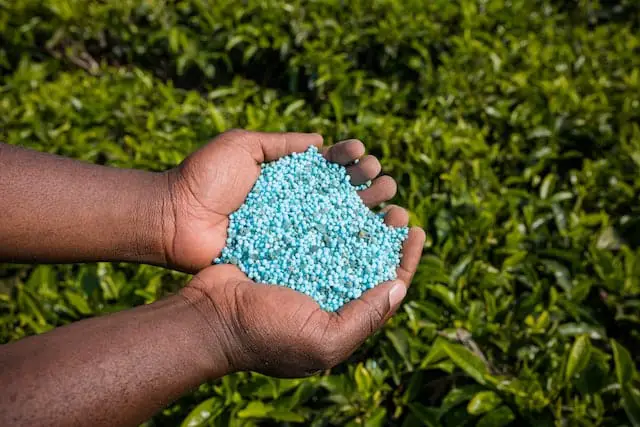
Majesty palms are a popular choice for indoor plants due to their elegant appearance and low-maintenance nature. However, they still require proper care in order to thrive. Here are some tips for keeping your majesty palm healthy and vibrant.
1. Watering Schedule
Majesty palms prefer consistently moist soil, but not waterlogged soil. It is important to water them thoroughly and allow the soil to dry out slightly before watering again.
Overwatering can lead to root rot, while underwatering can cause the leaves to turn yellow or brown. A good rule of thumb is to water the plant when the top 2-3 inches of soil feel dry to the touch.
2. Light and Temperature Requirements
Majesty palms thrive in bright, indirect sunlight. They can also tolerate low light conditions, but growth may be slower. It is important to avoid direct sunlight, as this can burn the leaves. They prefer temperatures between 60-85°F (15-29°C) and can be sensitive to cold drafts.
3. Fertilizing and Nutrient Management
Majesty palms benefit from regular fertilization during the growing season (spring and summer). A balanced, water-soluble fertilizer can be applied every 2-3 weeks. It is important not to over-fertilize, as this can cause salt buildup in the soil and damage the roots.
Nutrient deficiencies can also cause yellowing or browning of the leaves, so it is important to ensure the plant has adequate access to nutrients.
4. Pruning and Maintenance
Majesty palms do not require extensive pruning, but dead or yellowing leaves can be removed to maintain the plant’s appearance. It is important to use clean, sharp pruning shears to avoid damaging the plant.
Regular maintenance, such as wiping the leaves with a damp cloth to remove dust and debris, can also help keep the plant healthy.
Reviving a Sick Majesty Palm

If your Majesty Palm is turning yellow or brown, it might be sick and in need of some care. There are several reasons why a Majesty Palm might be dying, including overwatering, underwatering, insufficient light, low humidity, and nutrient deficiency.
However, with the right care and attention, you can revive your Majesty Palm and restore it to health.
1. Repotting
One of the first things you should do when trying to revive a sick Majesty Palm is to check its roots. If the roots are rotting or overcrowded, it might be time to repot the plant. Repotting can help improve the plant’s health by providing it with fresh soil and more space to grow.
To repot a Majesty Palm, you should choose a pot that is slightly larger than the current one. Gently remove the plant from its old pot, and remove any dead or damaged roots. Place the plant in the new pot, and fill it with fresh soil. Water the plant thoroughly, and place it in a bright, indirect light.
2. Treating Pests and Diseases
Majesty Palms are susceptible to pests and diseases, which can cause the leaves to turn yellow or brown. Some common pests that can affect Majesty Palms include spider mites, mealybugs, and scale insects.
To treat these pests, you can use neem oil, which is a natural insecticide. Mix neem oil with water, and spray it on the plant, making sure to cover both sides of the leaves.
If your Majesty Palm is suffering from a disease, such as root rot or leaf spot, you should remove any affected leaves or parts of the plant. You can also treat the plant with a fungicide, which can help prevent the disease from spreading.
3. Restoring Nutrient Balance
A lack of nutrients can also cause Majesty Palms to turn yellow or brown. To restore the plant’s nutrient balance, you can fertilize it with magnesium, iron, or Epsom salts.
Magnesium and iron are essential micronutrients that can help improve the plant’s overall health. You can add these nutrients to the soil or spray them directly on the leaves.
Epsom salts, on the other hand, contain magnesium and sulfur, which can help improve the plant’s growth and color. To use Epsom salts, mix them with water and spray them on the plant’s leaves. However, be careful not to over-fertilize the plant, as this can cause more harm than good.
By following these steps and using a process of elimination to determine the cause of your Majesty Palm’s health problems, you can revive your plant and restore it to its former glory.
Preventing Future Issues
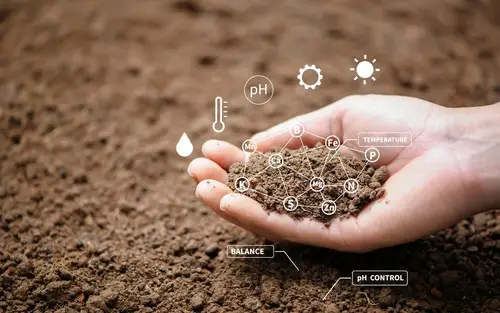
To prevent future issues with Majesty Palms turning yellow or brown, it is important to take proper care of the plant. This includes choosing the right soil, maintaining proper humidity, and avoiding common mistakes.
1. Choosing the Right Soil
Choosing the right soil is crucial for the health of Majesty Palms. The soil should be well-draining and rich in organic matter. A good soil mix for Majesty Palms consists of peat moss, perlite, and vermiculite. It is important to avoid soils that are heavy and retain too much moisture, as this can lead to root rot.
2. Maintaining Proper Humidity
Majesty Palms require high humidity levels to thrive. One way to maintain proper humidity is by misting the leaves regularly with water. Another way is to place the plant on a humidity tray filled with water.
This will help to increase the moisture level around the plant. It is important to avoid placing the plant near air conditioning or heating vents, as this can dry out the leaves.
3. Avoiding Common Mistakes
To avoid common mistakes, it is important to maintain consistent moisture levels in the soil. Overwatering can lead to root rot, while underwatering can cause the leaves to turn yellow and brown. It is important to check the soil moisture level regularly and water only when the soil is dry to the touch.
Another common mistake is not providing proper drainage. Majesty Palms require good drainage to prevent water from accumulating in the soil. It is important to ensure that the pot has drainage holes and that excess water can drain out easily.
Frequently Asked Questions
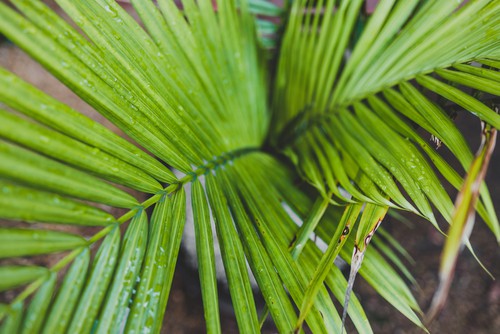
Why is my palm tree turning yellow and brown?
Yellowing and browning of palm leaves can be caused by several factors, including improper lighting, overwatering or underwatering, nutrient deficiencies, and pest infestations.
Majesty palms require filtered but bright sunlight, and exposing them to direct sunlight can result in sunburns and yellowing of leaves. Low light levels can also cause slow growth due to a lack of photosynthesis.
Should I cut yellow leaves off palm?
It is recommended to remove yellow leaves from a majesty palm to promote healthy growth. Yellow leaves are a sign of stress or damage, and they are unlikely to recover. However, it is important to avoid cutting off too many leaves at once, as this can shock the plant and hinder its growth.
How do you revive a browning majesty palm?
To revive a browning majesty palm, first identify the cause of the problem. If the issue is overwatering, reduce the frequency of watering and ensure proper drainage.
If the problem is underwatering, increase the frequency of watering and ensure that the soil is moist but not waterlogged. Nutrient deficiencies can be addressed by fertilizing the plant with a balanced fertilizer. Pests can be treated with insecticidal soap or neem oil.
Why is my majesty palm turning brown and crispy?
A majesty palm can turn brown and crispy due to underwatering, over-fertilization, low humidity, or pest infestations. If the soil is dry, increase the frequency of watering and ensure proper drainage.
Over-fertilization can cause salt buildup in the soil, which can damage the roots and cause brown, crispy leaves. Increase humidity around the plant by misting it regularly or placing a humidifier nearby.
Why are my potted palms turning yellow?
Potted palms can turn yellow due to underwatering, overwatering, nutrient deficiencies, or pest infestations. Ensure that the soil is moist but not waterlogged, and that the pot has proper drainage.
Fertilize the plant with a balanced fertilizer to address nutrient deficiencies. Pests can be treated with insecticidal soap or neem oil.
Can yellow palm leaves turn green again?
Yellow palm leaves are unlikely to turn green again, as they are a sign of stress or damage. However, removing the yellow leaves can promote healthy growth and prevent further damage to the plant.
It is important to address the underlying cause of the yellowing to prevent future damage to the plant.

Hey, I’m Lisa and I’ve been an avid gardener for over 30 years. I love writing, talking and living in the garden! Feel free to connect with me on my socials below

